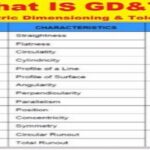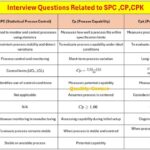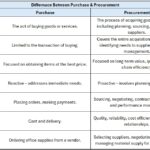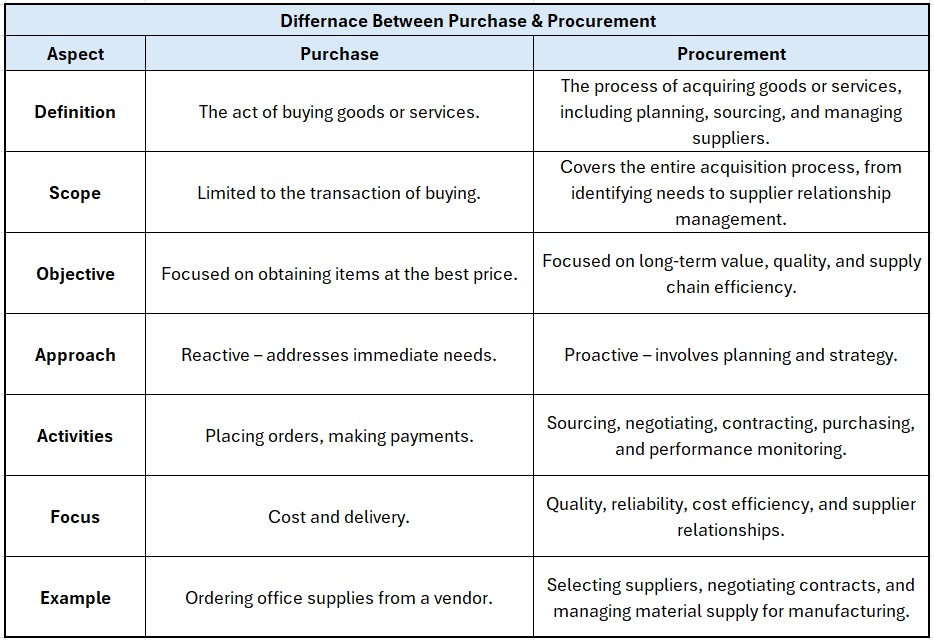In the world of supply chain management, understanding the difference between purchase and procurement is essential for professionals. These two terms are often used interchangeably, but they differ in scope, objective, and process. This article provides a detailed comparison, explaining their unique aspects and significance in business operations.
What is Purchase?
Purchase is a straightforward process that focuses on buying goods or services. It primarily deals with the transactional aspect of acquiring items for immediate use.
Key Characteristics of Purchase:
- Objective: The main goal is to fulfill a specific need quickly.
- Scope: Limited to issuing purchase orders and processing payments.
- Approach: Reactive – triggered by immediate requirements.
- Focus: Cost and delivery time.
- Example: Ordering office supplies or raw materials based on current needs.
What is Procurement?
Procurement is a broader and more strategic function that involves not just purchasing but also planning, sourcing, negotiating, and managing supplier relationships. It ensures the organization’s long-term goals are met efficiently.
Key Characteristics of Procurement:
- Objective: Focuses on achieving value, quality, and reliability over time.
- Scope: Encompasses all stages from identifying needs to managing supplier performance.
- Approach: Proactive – involves planning and strategy.
- Focus: Supplier relationship management, cost optimization, and risk management.
- Example: Selecting and negotiating with suppliers for a long-term contract to ensure quality and sustainability.
Comparison: Purchase vs Procurement
| Aspect | Purchase | Procurement |
|---|---|---|
| Definition | The act of buying goods or services. | The strategic process of acquiring goods or services. |
| Scope | Limited to the transaction. | Covers the entire acquisition process. |
| Objective | Focused on cost and delivery speed. | Focused on long-term value and efficiency. |
| Approach | Reactive – addresses immediate needs. | Proactive – involves planning and strategy. |
| Focus | Immediate requirements. | Quality, supplier relationships, and risk management. |
| Activities | Issuing orders and processing payments. | Sourcing, negotiating, and supplier development. |
Why Understanding the Difference Matters
Knowing the difference between purchase and procurement is crucial for businesses aiming to improve operational efficiency. While purchasing fulfills short-term needs, procurement ensures long-term sustainability and cost savings.
For example, a company focusing solely on purchasing may miss opportunities to negotiate better contracts, establish reliable supply chains, or reduce risks. Procurement professionals, on the other hand, strategically analyse market trends, supplier capabilities, and future needs to build a robust system.
External Reference
For a deeper understanding of procurement practices and their role in supply chain management, refer to the Chartered Institute of Procurement & Supply (CIPS).
Conclusion
The difference between purchase and procurement lies in their scope, objective, and strategic importance. While purchasing addresses immediate needs, procurement focuses on building long-term value and ensuring the organization’s overall success. Businesses that align their procurement strategies with their goals can achieve a competitive edge, reduce risks, and enhance efficiency.
By understanding these distinctions, professionals can make informed decisions that benefit both the short-term and long-term needs of their organizations.
Similar Articles:
- Top 15 MNCs Every Mechanical Engineer Dreams of Joining in 2025

- How to Digitize and Automate the CAPA Process

- Top 10 Essential Tools Every Mechanical Engineer Should Know

- What is GD&T (Geometric Dimensioning & Tolerancing) ?

- Principles of IATF 16949: A Guide to Quality Management

- The Evolution of IATF 16949: The Automotive Quality Standard

- Top Interview Questions Related to SPC ,Cp and Cpk

- Difference Between Purchase and Procurement

- Master Your Job Interview: Top 70 Common Interview Questions and Answers




